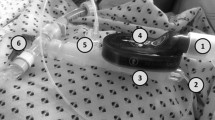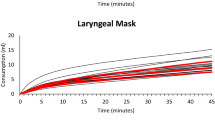Abstract
Health hazards from occupational exposure to trace concentrations of anesthetic gases cannot be definitively excluded. The aim of the study was to determine the surgeon’s occupational exposure to nitrous oxide and sevoflurane during pediatric surgical procedures. Twenty young children (age <10 years) and five teenagers (age > 10 years) underwent elective abdominal surgery under general inhalational anesthesia. The operating room was equipped with modern air conditioning and waste anesthetic gas scavenger. Levels of both nitrous oxide and sevoflurane were determined in the breathing zone of the surgeon and the anesthesiologist during the operative procedures by means of a direct-reading photoacoustic infrared spectrometer. Both the surgeon and the anesthesiologist were exposed to low concentrations of the inhalational agents used. Exposure to sevoflurane and nitrous oxide was clearly higher during surgery in young children than during operative procedures in teenagers. Nonetheless, the concentrations of these agents were well below the threshold limits of 25 ppm for nitrous oxide and 2 ppm for sevoflurane recommended by the National Institute of Occupational Safety and Health. General anesthesia results in operating room air pollution with inhalational anesthetics. Under modern air conditioning, personnel’s occupational exposure is low, and inhalational anesthesia is safe from the standpoint of modern workplace laws and health care regulations. Nonetheless, all efforts must be taken to maintain occupational exposure at this low level.
Résumé
Objectives: Des risques en rapport avec l’exposition à des gaz d’anesthésie ne peuvent étre totalement écartés. Le but de cette étude a été de déterminer le risque qu’encourt le chirurgien avec le protoxyde d’azote et le sevoflurane pendant des procédés chirurgicaux pédiatriques. Méthodes: 20 enfants (âge≥ 10 ans) et cinq adolescents (âge≥ 10 ans) ont eu une intervention abdominale élective sous anesthésie générale par inhalation. La salle d’opération était équipée d’un système de ventilation moderne et d’une cartouche filtrante pour les gaz anesthésiques non utilisés. Les niveaux de protoxyde d’azote et de sevoflurane ont été déterminés dans l’environnement respiré par les chirurgiens et les anesthésistes pendant les opérations par un spectromètre infrarouge photo-acoustique de lecture directe. Résultats: Et le chirurgien et l’anesthésiste ont été exposés à des concentrations basses des agents utilisés. L’exposition au sevoflurane et au protoxyde d’azote était fortement plus élevée lorsqu’il s’agissait d’enfants plus jeunes par rapport aux adolescents. Néanmoins, les concentrations de ces agents étaient bien plus basses que les valeurs seuils de 25 ppm pour le protoxyde d’azote et de 2 ppm pour le sevoflurane, recommandées par le National Institute of Occupational Safety and Health. Conclusions: L’anesthésie générale provoque une certaine pollution de la salle d’opération par des produits d’anesthésie d’inhalation. Dans les conditions modernes de ventilation, l’exposition aux gaz est trés réduite et l’anesthésie d’inhalation peut être considérée comme un procédé sur d’un point de vue médico-légal et selon les réglementations des conditions de travail. Néanmoins, toutes les précautions doivent être prises pour maintenir les niveaux d’exposition à des niveaux les plus bas possibles.
Resumen
No puede excluirse con certeza que la exposición, por motivos laborales a pequeñas concentraciones de gases anestésicos, pueda poner en peligro la salud de los profesionales. El objetivo de este trabajo fue determinar el grado de exposición de los cirujanos al óxido nitroso y al sevoflurano durante intervenciones quirúrgicas pediátricas. Métodos: 20 niños (menores de 10 años) y 5 adolescentes (mayores de 10 años) sufrieron una intervención quirúrgica abdominal bajo anestesia general por inhalación. El quirófano estaba equipado con una moderna instalación de aire acondicionado y un sistema eliminador de los gases anestésicos sobrantes. Utilizando un espectrómetro infrarrojo con lectura directa foto-acústica se determinaron los niveles de óxido nitroso y de sevoflurano en la zona en la que respiraban, durante la intervención, tanto el cirujano como el anestesista. Resultados: ambos, anestesista y cirujano, estuvieron expuestos a la inhalación a baja concentración de los agentes anestésicos utilizados. La exposición tanto al sevoflurano como al óxido nitroso fue significativamente superior durante la cirugía infantil que en las intervenciones quirúrgicas en adolescentes; sin embargo, ninguna de las concentraciones de los agentes anestésicos estuvieron por encima del umbral recomendado por el Instituto Nacional de Seguridad Laboral y Salud (25 ppm para el óxido nitroso y 2 ppm para el sevoflurano). Conclusiones: la anestesia general produce una polución del aire del quirófano cuando se utilizan anestésicos por inhalación. Si existe una moderna instalación de aire acondicionado, la exposición del personal laboral es muy baja y la anestesia por inhalación es segura, tanto desde el punto de vista de las modernas leyes laborales como de las regulaciones sobre atención sanitaria; a pesar de ello, no debe ahorrarse ningún esfuerzo para mantener la polución a estos bajos niveles.
Similar content being viewed by others
References
Klatskin, G., Kimberg, D.V.: Recurrent hepatitis attributable to halothane sensitization in an anesthetist. N. Engl. J. Med.280:515, 1969
Cohen, E.N., Bellvielle, J.W., Brown, B.W.: Anesthesia, pregnancy, and miscarriage: a study of operating room nurses and anesthetists. Anesthesiology35:343, 1971
Corbett, T.H., Cornell, R.G., Lieding, K., Endres, J.L.: Incidence of cancer among Michigan nurse-anesthetists. Anesthesiology38:260, 1973
Cohen, E.N., Brown, B.W., Bruce, D.L., Cascorbi, H.F., Corbett, T.H., Jones, T.W., Whitcher, C.E.: Occupational disease among operating room personnel: a national study. Anesthesiology41:321, 1974
Corbett, T.H., Cornell, R.G., Endres, J.L., Lieding, K.: Birth defects among children of nurse-anesthetists. Anesthesiology41:341, 1974
Baden, J.M., Kelly, M.J., Cheung, A.: Lack of mutagens in urine of operating personnel. Anesthesiology53:195, 1980
Cohen, E.N., Brown, B.W., Wu, M., Whitcher, C.E., Brodsky, L.R., Gift, H.C., Greenfield, W., Jones, T.W., Driscoll, E.J.: Occupational disease in dentistry and chronic exposure to trace anesthetic gases. J. Am. Dent. Assoc.101:21, 1980
Sweeney, B., Bingham, R.M., Amos, R.J., Petty, A.C., Cole, P.V.: Toxicity in bone marrow of dentists exposed to nitrous oxide. B.M.J.291:567, 1985
Karelova, J., Jablonicka, A., Gavora, J., Hano, L.: Chromosome and sister-chromatid exchange analysis in peripheral lymphocytes, and mutagenicity of urine in anesthesiology personnel. Int. Arch. Occup. Environ. Health64:303, 1992
Karakaya, A., Tuncel, N., Yucesoy, B., Akin, M., Cuhruk, H., Sardas, O.S., Beksac, M.: The effects of volatile anaesthetic agents on human immune system function via occupational exposure. Immunopharmacol. Immunotoxicol.14:251, 1992
Malhotra, S.K., Dhananjaya, P.R., Singh, H., Pershad, D.: Effect of halothane on motor skills and memory in anaesthetists. Indian J. Med. Res.98:218, 1993
Chang, W.P., Lee, S., Tu, J., Hseu, S.: Increased micronucleus formation in nurses with occupational nitrous oxide exposure in operating theaters. Environ. Mol. Mutagen.27:93, 1996
Lucchini, R., Placidi, D., Toffoletto, F., Alessio, L.: Neurotoxicity in operating room personnel working with gaseous and nongaseous anesthesia. Int. Arch. Occup. Environ. Health68:188, 1996
National Institute of Occupational Safety and Health (NIOSH): NIOSH Pocket Guide to Chemical Hazards. Washington, DC, U.S. Government Printing Office, 1994
Guirguis, S.S., Pelmear, P.L., Roy, M.L., Wong, L.: Health effects associated with exposure to anaesthetic gases in Ontario hospital personnel. Br. J. Ind. Med.47:490, 1990
Rowland, A.S., Baird, D.D., Weinberg, C.R., Shore, D.L., Shy, C.M., Wilcox, A.J.: Reduced fertility among women employed as dental assistants exposed to high levels of nitrous oxide. N. Engl. J. Med.323:993, 1992
Rowland, A.S., Baird, D.D., Shore, D.L., Weinberg, C.R., Savitz, D.A., Wilcox, A.J.: Nitrous oxide and spontaneous abortion in female dental assistants. Am. J. Epidemiol.141:531, 1995
Breum, N.O., Kann, T.: Elimination of waste anaesthetic gases from operating theatres. Acta Anaesthesiol. Scand.32:388, 1988
Hobbhahn, J., Hoerauf, K., Wiesner, G., Schroegendorfer, K., Taeger, K.: Waste gas exposure during desflurane and isoflurane anaesthesia. Acta Anaesthesiol. Scand.42:864, 1998
Hoerauf, K., Funk, W., Harth, M., Hobbhahn, J.: Occupational exposure to sevoflurane, halothane and nitrous oxide during paediatric anaesthesia. Anaesthesia52:215, 1997
Byhahn, C., Westphal, K., Wilke, H.J., Lischke, V.: Occupational exposure during mask induction and use of different types of endotracheal tubes. Anaesth. Intensivmed.39:627, 1998
Westphal, K., Strouhal, U., Kessler, P., Schneider, J.: Sevoflurane contamination during paediatric bronchoscopy. Anaesthesist46:677, 1997
Sik, M.J., Lewis, R.B., Eveleigh, D.J.: Assessment of a scavenging device for use in paediatric anaesthesia. Br. J. Anaesth.64:117, 1990
Imberti, R., Preseglio, I., Imbriani, M., Ghittori, S., Cimino, F., Mapelli, A.: Low flow anaesthesia reduces occupational exposure to inhalation anaesthetics. Acta Anaesthesiol. Scand.39:586, 1995
Byhahn, C., Westphal, K.: Causes of nitrous oxide contamination in operating rooms. Anesthesiology91:1960, 1999
Author information
Authors and Affiliations
Corresponding author
Rights and permissions
About this article
Cite this article
Byhahn, C., Heller, K., Lischke, V. et al. Surgeon’s occupational exposure to nitrous oxide and sevoflurane during pediatric surgery. World J. Surg. 25, 1109–1112 (2001). https://doi.org/10.1007/BF03215855
Issue Date:
DOI: https://doi.org/10.1007/BF03215855




